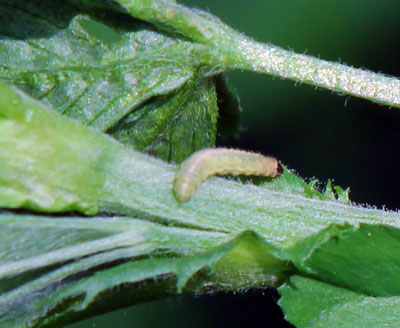Proper IPM for alfalfa weevils provides a basis for treatment
Alfalfa weevil scouting techniques and a good sweep net are tools that can be used for all alfalfa producers.
Alfalfa producers are anxiously looking at the calendar, checking the daily temperatures and thinking ahead to prepare for the harvest of their fields in the next few weeks. Because many alfalfa pests are tied to weather and temperature, it’s important to have a plan looking at possible scenarios for pest management. Michigan State University Extension considers the use of integrated pest management (IPM) techniques as the basis for making management decisions for control.
IPM is a pest management strategy that utilizes a wide range of control methods or tactics. The goal of this strategy is to prevent pests from reaching economically or aesthetically damaging levels with the least risk to the environment.
 This article will focus on one of the major first cutting alfalfa pests, the alfalfa weevil. Alfalfa weevil is a common insect defoliator that usually affects first cutting alfalfa. The weevil overwinters as adults in fields, fence rows, wood lots, etc., and emerges in early spring. The adults will feed on the new growth and lay eggs inside alfalfa stems. Once the eggs hatch, the larvae will feed for three to four weeks depending on the alfalfa quality and temperature.
This article will focus on one of the major first cutting alfalfa pests, the alfalfa weevil. Alfalfa weevil is a common insect defoliator that usually affects first cutting alfalfa. The weevil overwinters as adults in fields, fence rows, wood lots, etc., and emerges in early spring. The adults will feed on the new growth and lay eggs inside alfalfa stems. Once the eggs hatch, the larvae will feed for three to four weeks depending on the alfalfa quality and temperature.
Older stands should be checked first and considered to be more at risk due to the greater potential of having adults overwinter in the field. Younger or new seedings are also at risk, but should be scouted before any controls are considered. Also, realize that every field may have different amounts of infestation.
To scout for alfalfa adults emergence early in the season, a sweep net should be used. The adult is a gray-brown snout beetle with a dark stripe down its back. Larvae are green, 1/16 to 3/8 inches caterpillars with a white stripe down the back with a black head.
To scout for larvae, before first cutting sample 20 stems in five different locations of the field looking for larvae and damage. The damage will normally be in the uppermost leaves and appear as small shot holes in the foliage.
The threshold for control before first cutting is 40 percent of the stems are damaged, plus live larvae present. The first option to consider is cutting the field. If the field is going to be cut within seven days, consider cutting earlier. If the field is not going to be cut in seven days or less, pesticide applications may be considered. Remember that many beneficial insects are also controlled in the field including honey bees. Many of these beneficial insects will be harmed with pesticides that have a residual effect.
For more information, contact Phil Kaatz at kaatz@msu.edu or call 810-667-0341.



 Print
Print Email
Email



